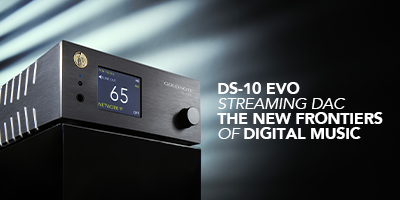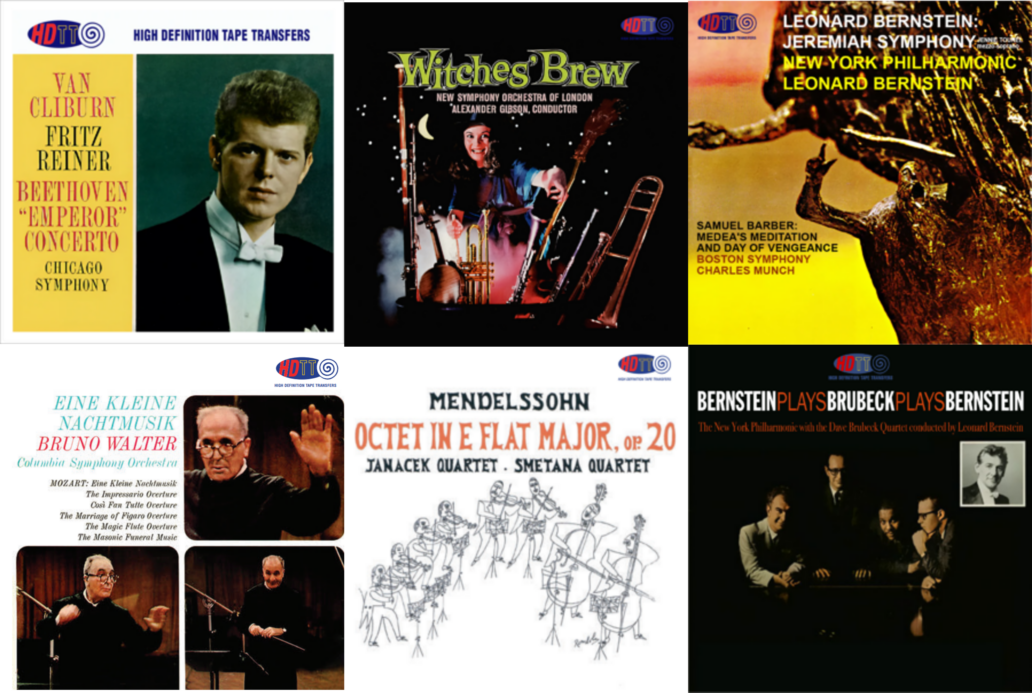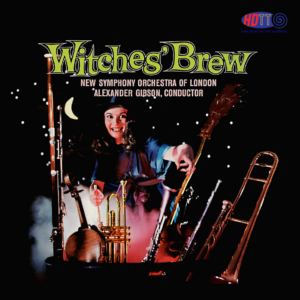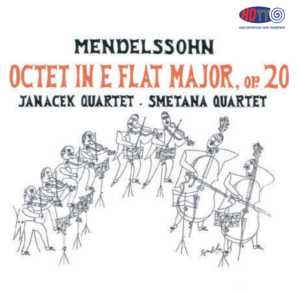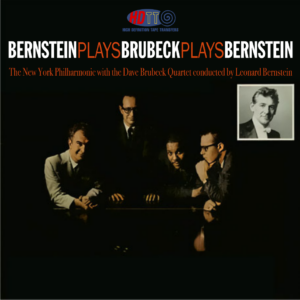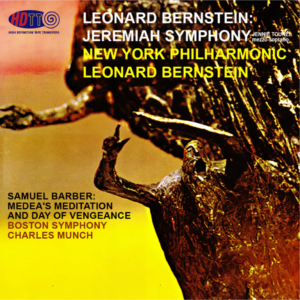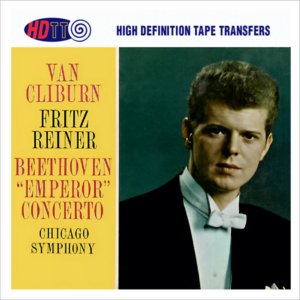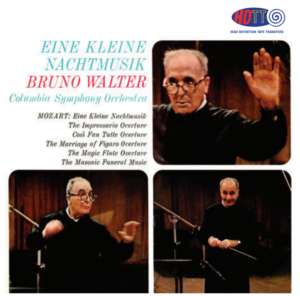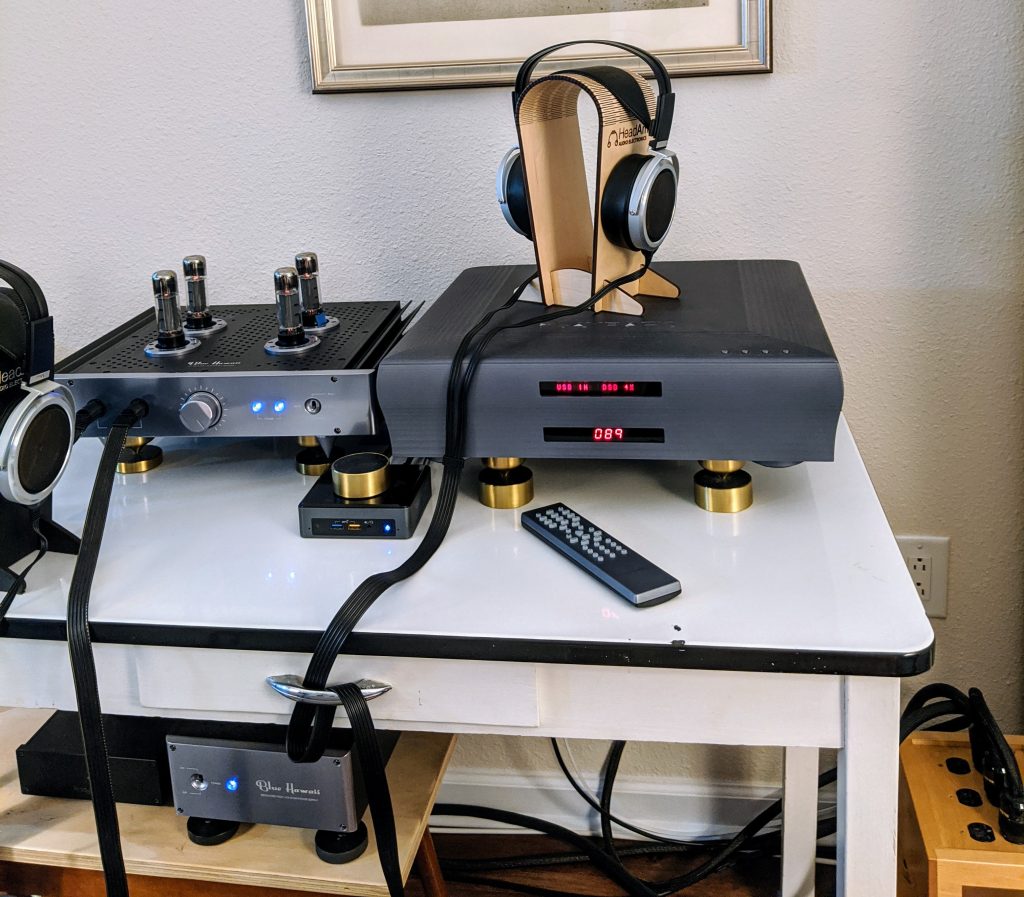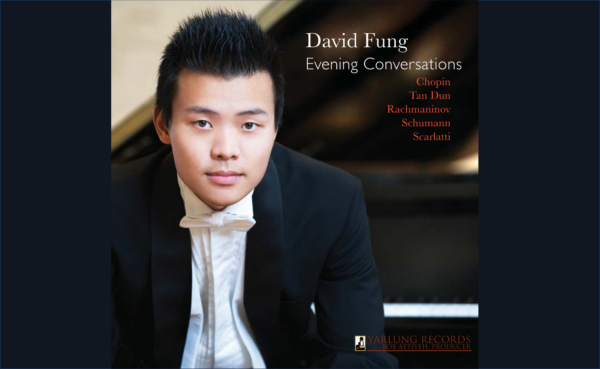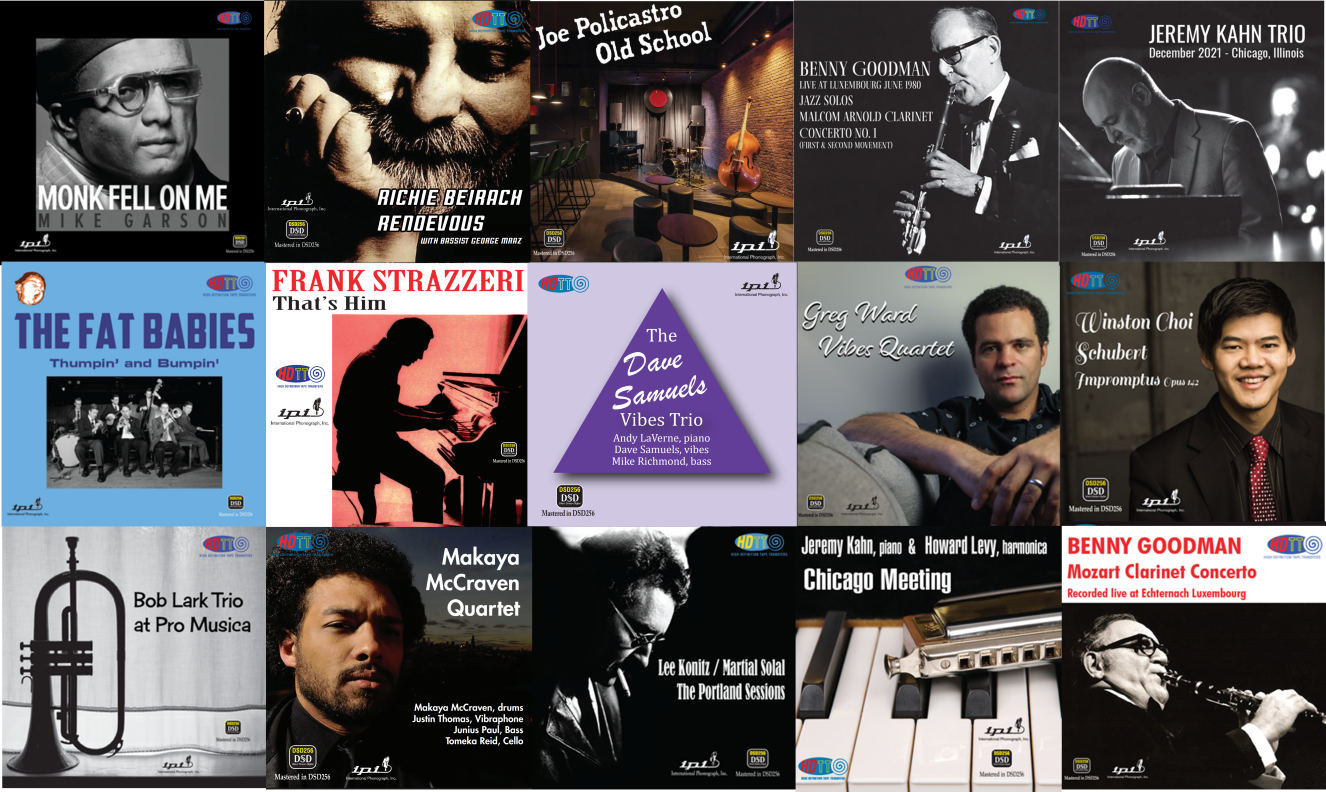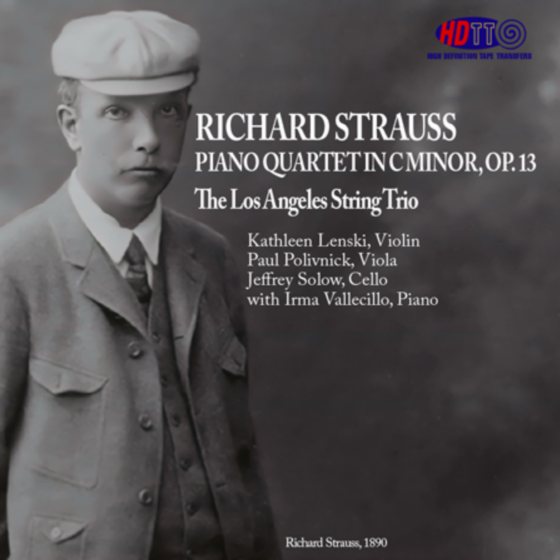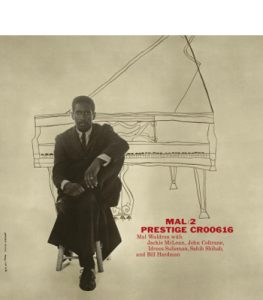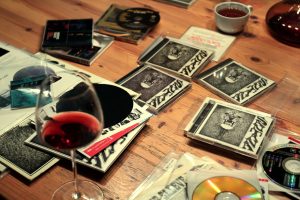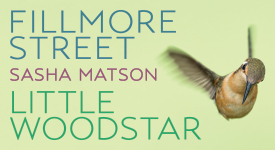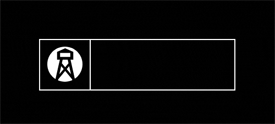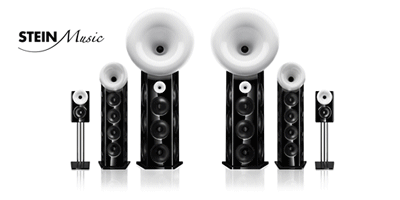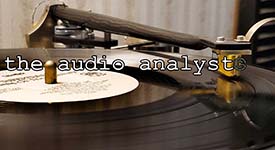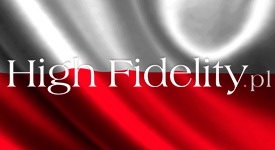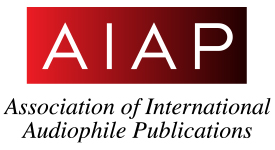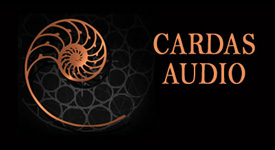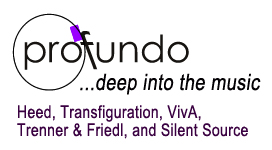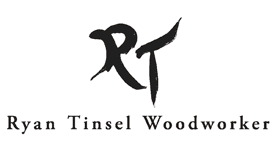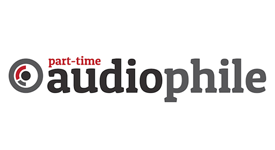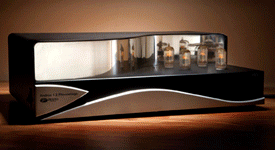Bob Witrak has been busy these past months with additions to the HDTT catalog. The biggest news is that the International Phonograph Jazz recordings are back! See my earlier note about this great news, HERE. Below are some of the new reissues (not IPI) that have caught my ear in recent weeks.
Witches Brew, Alexander Gibson, New Symphony Orchestra of London. HDTT 1959 2025 (DSD256, DXD) HERE
Witches Brew is an iconic audiophile delight. Ever since it's release on the RCA Living Stereo label, this album has been a regular visitor to audiophiles' playback systems to show off dramatic large-scale orchestral music masterfully performed and in great sonics. Recorded in Kingsway Hall on 5-6 Dec 1957 by the legendary Decca recording team of Kenneth Wilkinson and Alan Reeve under contract to RCA, this recording shows what is possible from the golden age of stereo.
For those who may not be familiar with this album, the music contained is a dynamic combination of works sure to tickle the hearts of those loving full range orchestral recordings with lots of percussion, bass, and drama:
1. Arnold - Overture To "Tam O'Shanter" Op. 52
2. Mussorgsky - Gnomus From "Pictures At An Exhibition"
3. Mussorgsky - A Night On Bare Mountain
4. Saint-Saëns - Danse Macabre Op. 40
5. Humperdinck - Witches' Ride From "Hansel And Gretel"
6. Liszt - Mephisto Waltz
This reissue is sourced from an original RCA Living Stereo 1/S 1/S pressing (LSC 2225), another excellent release in HDTT's ongoing Vinyl Record Restoration series. Yes, it does reflect some of the challenges heard in early Living Stereo pressings. There is the occasional congestion on massive forte sections. But, overall, this digital transfer is open, clean, utterly without background noise, with extended frequency response both high and low, and gorgeously analog sounding. If you play vinyl and have the four sides 45-rpm reissue that Classic Records released, you probably don't need this reissue. My recollection of that 45-rpm vinyl reissue is that it was clearly superior (as in knock your socks off and blow you out of your chair). But, but, but... If like me you no longer have vinyl playback, this is a very nice digital substitute.
For those who still have vinyl playback, note that Analogue Productions has a nice vinyl reissue mastered by Willem Makee, currently priced at $40 (HERE) so it is not unobtainium. (It is likely not the equal of the 45-rpm reissue I mentioned, however.) And, there is always Discogs to haunt. I don't have the RCA CD or SACD, so I can't offer you any comments on a listening comparison.
For me, I am just in heaven listening to this DSD256 release from HDTT. It sounds exactly like my memory of the RCA pressings, and that is fantastic in my book.
Mendelssohn Octet, Janáček Quartet and Smetana Quartet. HDTT 1959 2025 (DSD256, DXD) HERE
Glorious music! A transfer and reissue to celebrate! This is a recording revered for the combination of the two great Czech string quartets, the Janáček and the Smetana, in a transcendent performance of Mendelssohn's early masterpiece, the Octet in E-flat major, Op. 20.
Recorded and originally released by Westminster (WST 14082, 1959) the recording quality is superb. It was later reissued by HMV (1966) and by Supraphon (1968). In this transfer, Bob Witrak has managed to gain access to a 15ips 2-track Production Master analog tape for his source. And the resulting sound quality of this HDTT reissue is to die for. It is simply the finest iteration of this great recording that I can recall hearing.
There are other excellent performances of this work in the catalog. The Vienna Octet on Decca/London, the Academy of Saint Martins in the Field Ensemble on Argo, and the famed Heifetz-Piatigorsky Concerts on RCA, are good examples. But this performance by the combined Janáček and Smetana Quartets continues as my preferred performance of this work. It just checks all the boxes.
"A deceptively simple and thoroughly congenial work, the Octet boasts a wealth of invention," writes Peter Gutman in his excellent discussion of this work in Classical Notes, 2013 HERE. I recommend his article for an in depth discussion of this work and the challenges of assembling an ensemble to perform it.
If you love great chamber music, don't hesitate adding this album for your music library. Once you hear it, you will regret every month gone by without it.
Bernstein Plays Brubeck Plays Bernstein. HDTT 1961 2025 (DSD256 DXD) HERE
Bernstein Plays Brubeck Plays Bernstein is a jazz-classical crossover album featuring Leonard Bernstein, the New York Philharmonic, and the Dave Brubeck Quartet. It is divided into two sections. First, Bernstein and the NYP performing a work composed by Howard Brubeck (Dave Brubeck’s brother) with the Quartet providing a structured yet improvisatory dialogue with the orchestra. And second, the Dave Brubeck Quartet performing their own jazz arrangements of songs from Bernstein's West Side Story and Wonderful Town. It is clearly a collaboration born of the tremendous public response to West Side Story and an opportunity for Columbia to further monetize its popularity along with Bernstein and Dave Brubeck. I admit to not being particularly engaged by the Howard Brubeck work performed by the NYP, but hearing the jazz quartet riffing off the orchestra throughout the work was interesting.
The second section with the Dave Brubeck Quartet playing arrangements of Bernstein songs I found very engaging and nicely arranged by Brubeck and Desmond, if just a tad reverential.
Sourced from a 15ips 2-track tape, the sound is open, clear and dynamic. The Orchestra section was recorded at St. George Hotel Ballroom, Brooklyn, New York, a venue known for its superb acoustics and frequently used by Columbia for recordings of the NYP. Columbia recording engineers Fred Plaut and Frank Bruno also engineered the recordings of Rhapsody in Blue and An American in Paris by Bernstein and the NYP, both of which are also very nicely done, capturing good detail if at the cost of some close multi-miking resulting in less spacious sound, just as here.
Bernstein's Symphony No. 1 "Jeremiah" with Leonard Bernstein and the New York Philharmonic, and Samuel Barber's "Medea" with Charles Munch and the Boston Symphony Orchestra. HDTT 1962|1958, 2025 (DSD256, DXD) HERE
Leonard Bernstein was a mere twenty-four years old in 1942 when he composed his first symphony, which he subtitled Jeremiah after the biblical prophet. The work won the New York Music Critics' Circle Award for the best American work of 1944.
This 1961 recording of Jeremiah with Bernstein conducting is justly celebrated. It is a marvelous performance in excellent sonics, as heard here in this transfer from a 2-track tape. The first two movements, "Prophecy" and "Profanation," are instrumental and the third, "Lamentation," adds to the orchestra a solo mezzo-soprano—in this recording the exceptional Jennie Tourel whose performance has rarely been equaled in later recordings by other groups. The music is intended to retell a prophet’s warning to Jerusalem, its subsequent invasion by the Babylonians, and Jeremiah’s song of lamentation. Lots of drama, lots of regret. Great stuff.
HDTT has coupled this release with an exceptional performance of Samuel Barber's Medea's Meditation and Dance of Vengeance performed by Charles Munch and the Boston Symphony Orchestra. Barber's ballet score Medea was commissioned for use by Martha Graham in a 1946 performance. From this complete score, Barber next arranged a seven-movement orchestral suite that was first performed in 1948 by Eugene Ormandy and the Philadelphia Orchestra.
In 1955, Barber rescored and re-arranged some of this material into the condensed 12-minute orchestral work performed here. The music focuses on the emotional journey of Medea herself, from tenderness towards her children, to suspicion and then anguish of her husband's betrayal, to determination to take revenge, to the wild frenzy of the "Dance of Vengeance." Recorded in 1957 in Symphony Hall, this is one of the great Richard Mohr and Lewis Layton collaborations. This compact work is scored deliciously for a wide range of instruments, color, and drama. The concluding section is demonically intense, filled with impact from the large percussion section arrayed for the performance (tam tam, tom-tom, orchestral side drum, bass drum, whip, tympani, triangles, and cymbals). It is a wild ride! And Lewis Layton captures it well.
Beethoven Piano Concerto No. 5 "Emperor," Van Cliburn, Fritz Reiner, Chicago Symphony. HDTT 2025 (DSD256, DXD) HERE
This has long been identified as one of the classic performances of Beethoven's Emperor Concerto. It is a powerful, dramatic performance. As has always been the case with this recording, the piano is closely miked forcing it out in front of the orchestra in the soundstage and occasionally over-driving the microphones. But that is a nit. Take this performance as a whole and you can well see why Van Cliburn was such a high profile performer of the day. Reiner and the CSO match him stride for stride.
This performance of the Emperor can well be on anyone's short list of the best 2 or 4 recordings of this work. Love or not Van Cliburn's playing style, one cannot deny his proficiency and technique. He was a great pianist. And I rather love this big-boned, full-bodied, and powerful approach. No mamby-pamby here. The transition from the powerful first movement into the glowingly soft, sentimental, and slow second movement "Adagio" carries all the greater contrast. It is as beautifully played as any in the catalog.
Of course, as good as this is, don't let it be your only recording of the Emperor. You should really listen to the performances of Arthur Rubinstein, Wilhelm Kempff, Julius Katchen, and Rudolf Serkin, among others. And for a contemporary take, listen to the excellent performance by Hannes Minnaar with The Netherlands Symphony Orchestra conducted by Jan Willem de Vriend (see my review HERE). But, among all of these, Van Cliburn's performance holds a special place in my mind for its warmth, power, and grandeur.
Sourced from 4-track tape, the sound is better than I've heard on the RCA released LPs over the decades. Perhaps one day Bob Witrak will be able to reissue this from an even better source—he is quite amazing in this respect. I did compare this release to alternate CD and SACD reissues, but they did not hold up against the comparison. The SACD sounded sweet, but also rolled off and lacking energy, the CD simply doesn't merit discussion. For now, this is my go-to release of this album.
Mozart Eine Kleine Nachtmusik, Bruno Walter, Columbia Symphony Orchestra. HDTT 1961 (DXD, DSD128) HERE
This is a grand album which has brought me great enjoyment over the many decades it has been in my music library in one incarnation or another. It continues to hold up well as one of the most congenial traversals of several Mozart works, beginning with Eine Kleine Nachtmusik. If you are seeking to introduce someone to the joys of classical music, the works of Mozart are a delightful way to ease into the genre. Eine Kleine Nachtmusik is one of the most engaging places to start and this performance by Bruno Walter and the Columbia Symphony Orchestra is as pleasant, cheerful and spritely a source as any in the catalog. Yes, it is full orchestra. No, it is not historically informed performance style. What it is, though, is delightful music making by one of the masters interpreting Mozart.
Also included in the album are several overtures (Impressario, Cosi Fan Tutte, Figaro, Magic Flute) and The Masonic Funeral Music—all wonderful examples of Mozart's creative genius. (Can I say that? It seems such an overworked term, but so apt.)
This album is an old friend. The HDTT reissue is an absolute sonic delight. It's been in Bob Witrak's catalog long enough that it was transferred before he was making DSD256 releases, so this is DXD and DSD128. I don't know what his source may have been, but the overall result is clean, clear, open, and very dynamic. It is a reissue to treasure.

